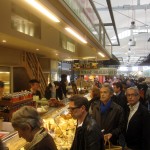This may be surprising to many Americans, but most of our food used to be alive. Before those chicken nuggets were ground and reshaped for dipping in colorful high-fructose corn syrup, they were chickens with beaks, feathers, and legs. Before our Blizzard was a shake, the cream came from a cow that mooed, had hooves, and smelled bad. (Of course, this is making a lot of assumptions about the amount of actual dairy in the land where the queen of dairy rules.)
But when I woke up and headed down to the Marché de Talensac this Saturday morning, there were no frozen, breaded chicken nuggets, and certainly no ice-cream of questionable dairy content. Instead, I was greeted by live animal products, freshly killed meat, and smelly cheese which hadn’t been killed by over-pasteurization. (In France, they recognize that cheese is the delicious result of milk turned rancid, and if you don’t like bacteria in your cheese or cheese with a strong smell, you don’t like cheese.)
When I visted Spain with fellow Gustavus student Andrei Hahn, he noted that the Spanish are not so removed from their food as Americans. The Spanish recognize that the meat they eat comes from a dead animal. When we ordered ham in Barcelona, it was cut off of the pig leg sitting on the bar. They don’t try to pretend that it isn’t an animal.
This was the same honesty about food I saw at the market on Saturday. Though some of the chickens were plucked, protruding from their bodies were grey, knobbly legs which ended in menacing sharp claws. It actually rather frightened me. I saw other birds which stared back at me with eyes framed by eye lids, lashes still protruding from the lids.
The seafood stands were even more lively. At one stand, there were piles of live shrimp and crawfish crawling over one another on a bed of ice. A woman behind the counter deftly snatched them up and put them in a sac for a customer. In a tank at another seafood booth were live lobsters crawling around next to each other. Down the counter from the tank were rows of full-bodied fish waiting to be cut and cleaned by the workers who busily responded to customers’ requests. One row of fish was interrupted when a worker whisked a fish over to the cutting board where it lost its head and was quickly rapped up for its buyer.
This was an exciting way to see the interaction between people and their food. It’s a step in the process I have never witnessed in the United States (though I’m certainly not suggesting it is 100% nonexistent there). Sometimes, the things I saw made me feel a bit squeamish. I’m used to a lot less contact with the living reality of my food: the blood, with the eyes, with the scales and the feathers.
But this messy reality is what lies behind our food whether we acknowledge it or not. So, I think I prefer the market model: where everyone acknowledges what they are buying. If we are ashamed, grossed out, or scared by the origins of our food, what business do we have eating it? If I can’t handle the process, or even the sight of the preparation, I’m not sure I should get to skip ahead to the results. It seems to me this is a very good way to distance ourselves from processes of which we wouldn’t approve if we were forced to encounter them before consuming the final product.
This doesn’t just apply to beheaded fish though. It applies to war, to other food and drink, to the luxuries we buy and the labor that goes into them. If we have to remove ourselves from the process, or don’t want to deal with the origins, we probably don’t actually approve of the final result.
I like chicken. But I wonder if I could watch one be killed and prepared. Let alone do it myself. If not, should I be eating it?
- A fish losing its head for sale.
- They are getting ready to purchase some delicious, bacteria-filled cheese.

